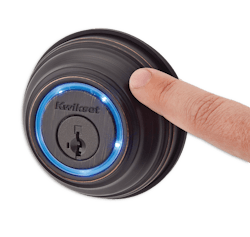Modern society is increasingly seeking new ways to simplify their lives. The ultimate goal is to fit more activities into the same space of time but with the least amount of added physical energy exerted. From check writing to credit cards and from U.S. mail to the Internet, successful inventions follow the same general theme. Society tends to embrace any idea which is easier and faster.
A majority of the booths at the 2014 ISC West conference will have new and inventive options to make commercial access control even that much better. A smaller amount of companies will be showing new security products for residential applications. According to the latest available statistics, there are approximately 114 million households in the U.S. The vast majority of these dwellings are equipped with pin tumbler lock systems, which have been the most common security product of choice for over a century.
It is time for a change in residential security and each of those 114 million households can be a potential customer. ADT has been one of the first companies to realize the sales possibilities and has an ongoing campaign to sell wireless electronic locking as an addition to their alarm services.
The first transition from key-operated locks to something easier was the push button lock. The physical interaction of inserting a key into the lock was replaced by the need to press several buttons to accomplish locking or unlocking. Push button locks are available with mechanical or electronic mechanisms, but the required physical action of pushing buttons is not much different from having to insert a key.
A new class of keyless residential locks is emerging. Wireless technology now allows a user to unlock their door by either just touching the face of the door lock or through no physical action at all, except to have a programmed fob or smartphone in pocket or purse. As the user comes in close proximity to the door, a wireless signal automatically alerts the lock to unlock.
In 2011, I was invited to visit a company in Michigan which was developing a mortise lockset for residences. A unique feature was that their lockset could be opened with a smartphone. Development costs and extremely decorative levers and hardware caused the list price to be approximately $2,500. Two years ago, only 35 percent of the population had a smartphone. However, as of last year, 56 percent of the population now has a smartphone. As the price of phone-operated locks decreases, the demand for this new class of locks will surely follow the upward increase in smartphone usage.
A few pre show samples of existing cellphone-operated locks are listed here. We will scour the ISC convention floor to find more electronic residential lock products for our next report.
Kevo
A new deadbolt lock from Kwikset is a good example of this new class of residential locksets. Kevo deadbolt locks can be programmed to allow either a keypad or smartphone to wirelessly operate the lock. When a Kwikset Kevo fob or smartphone is in close proximity to the door, the user only has to lightly touch any part of the outer lock cylinder or trim ring and the Kevo lock will unlock.
Goji
Goji deadbolts contain an internal camera which takes a picture of anyone who uses the lock. A user’s cellphone becomes the manager of their GOJI deadbolt. Deadbolt access can be sent by cellphone to friends or repairmen so they can gain access. Additionally, access can also be remotely removed at any time. The Goji mobile app allows users to automatically unlock the Goji lock as they approach the door.
Lockitron
Lockitron is an add-on for existing cylindrical deadbolts. A bracket is installed behind the existing inner turn knob and the Lockitron unit is fastened onto the bracket and fits onto the existing turn knob. Lockitron has built-in WiFi. A cellphone can control a Lockitron unit from anywhere in the world. Most cellphones can be programmed to operate the lock by sending text messages to unlock the door. Persons with iPhone models 4S or 5 can use touchless bluetooth programming to unlock a Lockitron unit when the smartphone is in close proximity to the door.
Viking Electronics
Although not a complete lockset such as the other products on this list, the Viking BTC-1 has a wider range of possible applications. The BTC-1 consists of a box which contains both N.O.or N.C. switches which can be controlled by a bluetooth-equipped cellphone. The most obvious lock application would be to operate an electric strike but other applications could include electric garage door openers, electric gate operators or any other access control system where a cellphone could be used to advantage.





